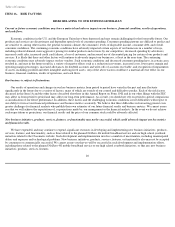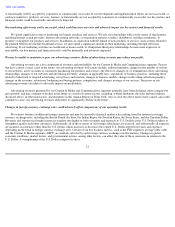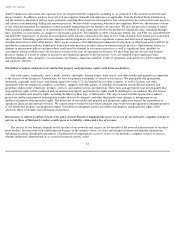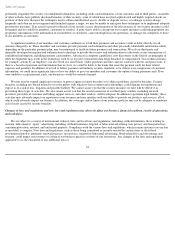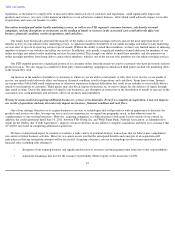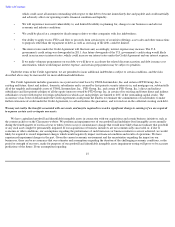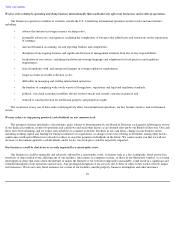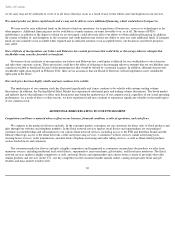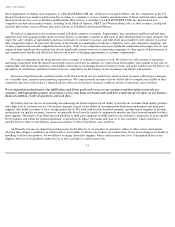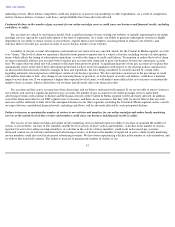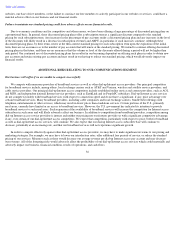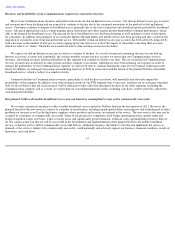NetZero 2011 Annual Report Download - page 29
Download and view the complete annual report
Please find page 29 of the 2011 NetZero annual report below. You can navigate through the pages in the report by either clicking on the pages listed below, or by using the keyword search tool below to find specific information within the annual report.
Table of Contents
which could cause all amounts outstanding with respect to that debt to become immediately due and payable and could materially
and adversely affect our operating results, financial condition and liquidity.
•
We will experience increased vulnerability to, and limited flexibility in planning for, changes to our businesses and adverse
economic and industry conditions.
• We could be placed at a competitive disadvantage relative to other companies with less indebtedness.
•
Our ability to apply excess FTD cash flow or proceeds from certain types of securities offerings, asset sales and other transactions
to purposes other than the repayment of debt, as well as servicing of the debt, could be limited.
• The interest rates under the Credit Agreement will fluctuate and, accordingly, interest expense may increase. The U.S.
government's credit rating was downgraded in 2011. Any future downgrade of the U.S. government's credit rating would likely
result in an increase in interest rates, which could increase our interest rates under the Credit Agreement and our interest expense.
• If we make voluntary prepayments on our debt, we will have to accelerate the related discount accretion and debt issuance cost
amortization, which would impact interest expense, and certain prepayments may be subject to penalties.
Under the terms of the Credit Agreement, we are permitted to incur additional indebtedness subject to certain conditions, and the risks
described above may be increased if we incur additional indebtedness.
The Credit Agreement includes guarantees on a joint and several basis by UNOL Intermediate, Inc. and certain of FTD Group, Inc.'s
existing and future, direct and indirect, domestic subsidiaries and is secured by first priority security interests in, and mortgages on, substantially
all of the tangible and intangible assets of UNOL Intermediate, Inc., FTD Group, Inc. and certain of FTD Group, Inc.'s direct and indirect
subsidiaries and first priority pledges of all the equity interests owned by FTD Group, Inc. in certain of its existing and future direct and indirect
subsidiaries (except with respect to foreign subsidiaries in which case such pledges are limited to 66% of the outstanding capital stock). The
occurrence of an event of default under the Credit Agreement could permit the lenders to terminate the commitments of such lenders to make
further extensions of credit under the Credit Agreement, to call and enforce the guarantees, and to foreclose on the collateral securing such debt.
We may not realize the benefits associated with our assets and may be required to record a significant charge to earnings if we are required
to expense certain costs or impair our assets.
We have capitalized goodwill and identifiable intangible assets in connection with our acquisitions and certain business initiatives such as
the content archives on the Classmates website. We perform an impairment test of our goodwill and indefinite-lived intangible assets annually
during the fourth quarter of our fiscal year or when events occur or circumstances change that would more likely than not indicate that goodwill
or any such assets might be permanently impaired. If our acquisitions or business initiatives are not commercially successful or, if due to
economic or other conditions, our assumptions regarding the performance of such businesses or business initiatives are not achieved, we would
likely be required to record impairment charges which would negatively impact our financial condition and results of operations. We have
experienced impairment charges in the past. Given the current economic environment and the uncertainties regarding the impact on our
businesses, there can be no assurance that our estimates and assumptions regarding the duration of the challenging economic conditions, or the
period or strength of recovery, made for purposes of our goodwill and identifiable intangible assets impairment testing will prove to be accurate
predictions of the future. If our assumptions regarding
27





